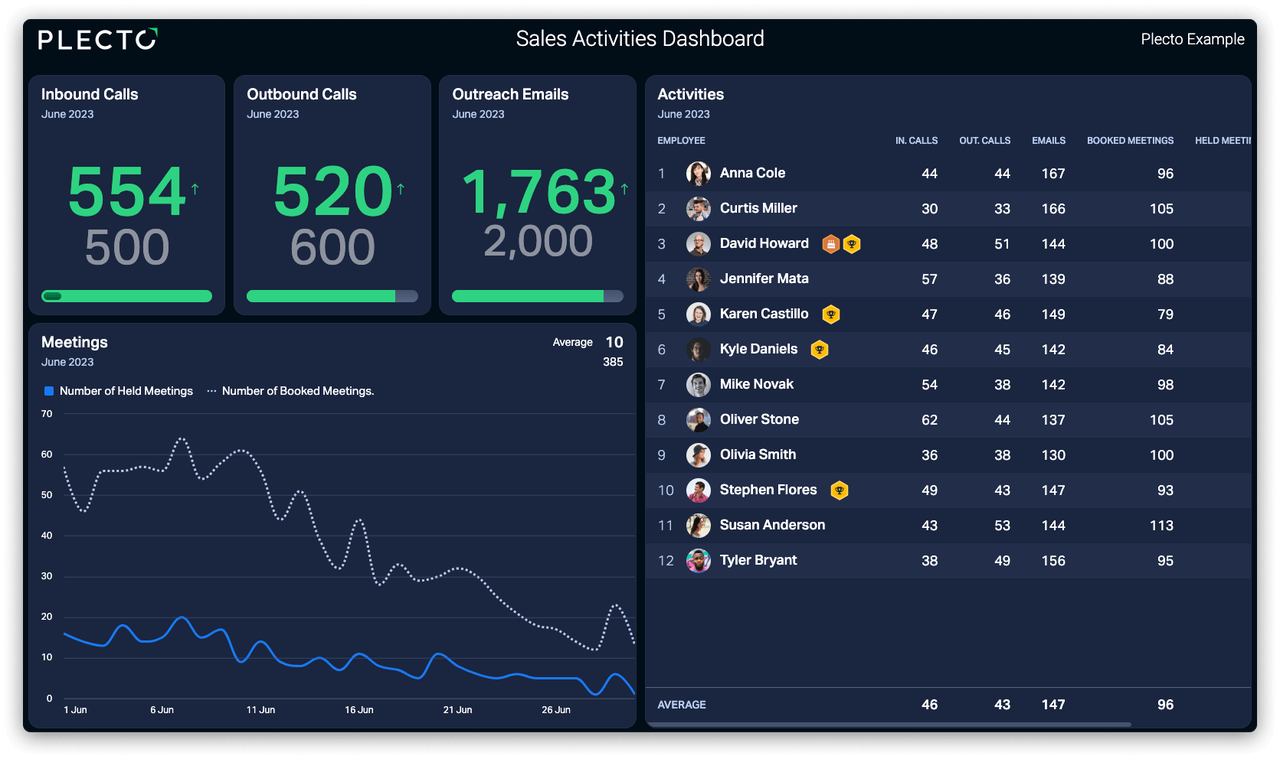The rise of vanity metrics in marketing and analytics has become an all-too-common occurrence in today's digital landscape. Vanity metrics are the superficial measurements of success that can give a false sense of accomplishment, but fail to provide meaningful insights into the effectiveness of a marketing campaign or the performance of a business.
Unfortunately, many organizations fall into the trap of focusing on vanity KPIs, which can lead to wasted time, effort, and resources. In this article, we'll discuss what vanity metrics are, how to identify them, and how to avoid the vanity KPI metrics trap.
Definition of Vanity Metrics
Vanity metrics are metrics used to measure success in a business that may look good on the surface but don’t actually indicate any meaningful progress or success.
They are often used to make a business look better than it really is, and they can be misleading and distracting. Therefore, avoiding these metrics in your marketing reporting is a good practice.
Examples of vanity metrics include the number of followers, likes, and page views a business has, as well as the number of downloads of an app or website.
Vanity metrics do not measure customer engagement, conversion rate, or revenue, so businesses should not rely on them as a measure of success.
Common Vanity Metrics
1. Number of Page Views
This is a vanity metric because it does not provide any insight into how engaged users are with a website or how effective a website is at converting users into customers.
A high page view count may simply mean that a website is receiving a lot of traffic, but that does not necessarily mean that the website is successful. A low page view, on the other hand, can result due to many reasons, including a slow website. However, it does not mean you should stop tracking this vanity metric. Instead, regularly check how your website is performing and how many visitors it gets to make improvements on time.
2. Number of Social Media Followers
This is a vanity metric because it does not provide any indication of the quality of a company’s followers. A high number of followers may mean that a company is popular, but it does not mean that they are engaged or that they are loyal customers.
3. Number of Downloads
The number of downloads does not provide any insight into how many people are actually using a product or how many people are returning customers. A high number of downloads may indicate that a product is popular, but it does not mean that it is successful.
4. Number of Likes
Surprisingly, this is actually a vanity metric because it does not provide any insight into how influential a company’s social media presence is. A high number of likes may simply mean that a company is popular, but it does not mean that its posts are being shared or engaged with. This is why you need more analytical data to go by offered by some social media analytics tools.
5. Number of Sign-Ups
This is a vanity metric because it does not provide any indication of how many people are actually using a product or how many customers are returning customers.
6. Number of Comments
This is a vanity metric because it does not provide any indication of how engaged users are with a company’s content. Remember - comments can be negative
7. Number of Email Subscribers
This is a vanity metric because it does not provide any indication of how engaged users are with a company’s emails. A high number of email subscribers may simply mean that your sign-up form and welcome emails are doing their job, but it does not mean that users are actually engaging with them.
8. Number of App Downloads
This is a vanity metric because it does not provide any indication of how many people are actually using a product or how many customers are returning customers. It’s natural that free apps will get tons of downloads, but it doesn’t mean they will convert people into paying customers effectively.

Why Vanity Metrics are Problematic
False impression of progress
Vanity metrics can be affected by external factors, such as market trends and competition, and therefore, they may not accurately reflect the true performance of a business. Vanity metrics can be particularly problematic when it comes to evaluating SEO performance.
For instance, a business may be experiencing an increase in website visitors but these visitors may not be converting into actual customers. In this case, the vanity metric of website visits may not be indicative of a real improvement in the business’s performance. Vanity metrics also tend to be short-term focused and may not take into account the long-term prospects of a business.
Poor decision making
Vanity metrics can lead to poor decision making because they often focus on the wrong things. For example, a business might track the number of page views or downloads of its product, but fail to track the number of returning customers. This can lead to decisions that are focused on increasing page views or downloads, rather than on increasing customer retention. However, this does not take into account the customer satisfaction or the customer lifetime value, both of which can provide a more realistic indication of how successful a product is.
Vanity metrics can also lead to inaccurate conclusions. For example, a business may track the number of likes on their social media posts and assume that this indicates the success of their marketing campaign. However, this metric alone does not provide an accurate indication of the success of the campaign, as it does not take into account other factors like the number of clicks or conversions from the posts.
Build your first dashboard.
Start your 14-day free trial today
How to Avoid the Vanity Metrics Trap
Set achievable, measurable goals
Achieving measurable goals is an important part of any successful business strategy. Setting goals and measuring them can help you focus on what’s important and ensure that you are making progress toward your desired outcomes.
It helps you to avoid falling into the “vanity KPI metrics trap” which is all about measuring the wrong things and spending time and money on activities that don’t contribute to your success.
To set achievable, measurable goals and avoid vanity KPI metrics, you should:
1. Start with a clear vision
A clear vision of what you want to accomplish should be your starting point. Without a strong vision, you won’t be able to measure your progress or know if you are achieving your goals. Make sure that your vision is realistic and achievable.
2. Set SMART goals
Once you have a clear vision, you need to set measurable goals that are SMART (Specific, Measurable, Achievable, Relevant and Time-bound). This will help you stay focused and ensure that you are working towards something concrete and achievable.

3. Break down goals into smaller chunks
Breaking down your goals into smaller chunks can help you manage them more effectively and make sure that you are making progress. It also makes it easier to review and adjust your goals if necessary.
4. Track performance
Once you have set your goals, you need to track your performance so that you can ensure that you are making progress and identify areas for improvement. Using metrics, such as the number of leads, conversions, revenue and customer satisfaction, can help you measure your progress and make sure that you are achieving your desired outcomes.
5. Stay focused
Finally, it’s important to stay focused on your goals and avoid getting distracted by vanity metrics. Don’t get caught up in measuring the wrong things or trying to hit unrealistic goals. Focus on the metrics that will help you achieve your desired outcomes and make sure that you are making progress. Following these steps will help you set achievable, measurable goals and avoid the vanity KPI metrics trap. It’s important to remember that goal setting and tracking performance is an ongoing process, so be prepared to review and adjust your goals as needed.
Track metrics that matter
There are a few steps to selecting metrics that actually matter for your business.
1. Understand what you want to track
Before selecting any metrics, you should have a clear understanding of what you want to track and why. Ask yourself what information you need to make decisions and how it will help you reach your goals.
2. Determine what's relevant
Once you know what you want to track, you need to determine which metrics are most relevant to your goals. Consider the size and scope of your project, the resources you have available, and the audience you’re trying to reach.
3. Gather data
Once you’ve identified the relevant metrics, you’ll need to gather the data. This could mean using analytics tools, surveying customers, or manually tracking data points.
4. Analyze the data
Once you have the data, you need to analyze it to understand if it’s telling you anything meaningful. Are the metrics you’re tracking really helping you reach your goals? If not, you may need to reevaluate your selection.
5. Monitor the metrics
Once you’ve selected the right metrics, it’s important to monitor them on a regular basis. This will help you identify any trends or changes that could affect your success.
6. Take Action
Finally, once you’ve identified any trends or changes, you need to take action to improve or adjust your strategy. This could include adjusting your budget, changing your tactics, or making other adjustments to ensure you’re reaching your goals.
Wrapping Up
Ultimately, avoiding the vanity KPI metrics trap is about understanding the distinction between vanity metrics and actionable metrics.
Vanity metrics provide a surface-level overview of a business, but they do not provide enough information to accurately assess performance or create meaningful, actionable strategies.
Actionable metrics, on the other hand, provide deeper insights into customer behavior and give a more accurate representation of the health of a business.
By choosing Plecto as your performance management tool, you'll be able to steer clear of the vanity KPI metrics trap and focus on the key performance indicators that genuinely impact your business's success. Give Plecto a try and see the difference it can make in your organization's performance and growth.
Managing brand partnerships at Respona, Vlad Orlov is a passionate writer and link builder. Having started writing articles at the age of 13, their once past-time hobby developed into a central piece of their professional life.




